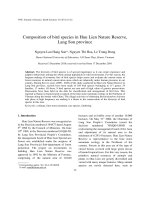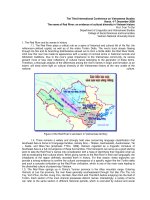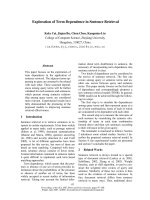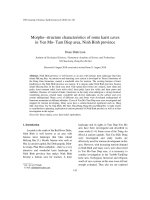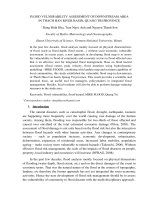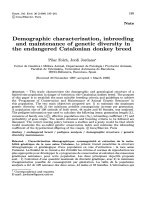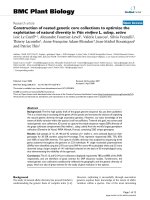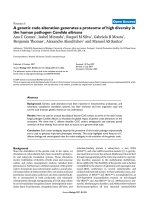Exploration of amphibian diversity in trang an landscape complex ninh binh province
Bạn đang xem bản rút gọn của tài liệu. Xem và tải ngay bản đầy đủ của tài liệu tại đây (1.6 MB, 100 trang )
MINISTRY OF AGRICULTURE AND RURAL DEVELOPMENT
VIETNAM NATIONAL UNIVERSITY OF FORESTRY
------------------------------------
STUDENT THESIS
EXPLORATION OF AMPHIBIAN DIVERSITY IN TRANG AN
LANDSCAPE COMPLEX, NINH BINH PROVINCE
Major: Natural Resources Management
Code: D850101
Faculty: Forest Resources and Environmental Management
Student: Nguyen Tuan Nam
Student ID: 1453090203
Class: K59A-Natural Resources Management
Course: 2014-2018
Advance Education Program
Developed in collaboration with Colorado State University, USA
Supervisor: Dr. Luu Quang Vinh
Ha Noi, Nov 20th 2018
ACKNOWLEDGEMENTS
I am really pleasure to have a chance to send my acknowledgments to people who
helped me a lot in the study, without whom this research would have never completed.
First and foremost, I would like to express my great appreciation to my respected
supervisor Dr. Luu Quang Vinh from Forest Resources and Environment Management
Faculty, Vietnam National University of Forestry (VNUF), who was patient to me and
gave me useful guidance and enthusiastic encouragement throughout my research work.
His great experience and knowledge is heavily embedded in this study.
I would like to extend my thanks to Mr. Pham Sinh Khanh – manager of Trang An
Landscape Complex (TA LC) for his supporting during my survey time.
Besides, I would love to thank Mr. Lo Van Oanh, Mr. Nguyen Huy Quang, Mr.
Nguyen Thanh Tung, Mr. Dang Quoc Tuan for their assistance in the field.
Therefore, I would like to thank Mr. Thanh and his wife - who management Tran
temple for supporting available transportation and shelters on the survey team.
Finally, I own my gratefully to my parents for their love, support and
encouragements to me throughout all my life. Even though difficulties, ado, they always
help me as more as possible for my dream.
This research is supported by the National Foundation for Science and Technology
Development (NAFORSTED, Grant No.106.06-2017.18)
i
ABSTRACT
This research was conducted to provide the checklist of amphibian‟s species in Trang
An Landscape Complex, Ninh Binh Province, Vietnam. Total 11 species were recorded
within survey from 8th May - 28th June 2017 and 28th May - 12 June 2018 in Trang An
Landscape Complex. The number of amphibian species in TA LC has increased to 19.
Remarkably, one new provincial species was recorded and described (Theloderma annae)
for the first time from Trang An and from Ninh Binh Province. This study described 11
amphibian species in Trang An Landscape Complex. The main threats to the amphibian
fauna is ecotourism. Therefore, the research has recommended three solutions for reducing
the threats consisting of managing, keeping and protecting amphibians in Trang An
Landscape Complex.
ii
TABLE OF CONTENTS
ACKNOWLEDGEMENTS ............................................................................... i
ABSTRACT ...................................................................................................... ii
TABLE OF CONTENTS ................................................................................. iii
ABBREVIATIONS........................................................................................... v
LIST OF FIGURES.......................................................................................... vi
LIST OF TABLES .......................................................................................... vii
CHAPTER I: INTRODUCTION ...................................................................... 1
CHAPTER II: LITERATURE REVIEWS ....................................................... 3
CHAPTER III: GOAL, OBJECTIVES AND STUDY SITE ........................... 7
3.1 Goal ......................................................................................................... 7
3.2 Objectives ................................................................................................ 7
3.3 Geographic location ................................................................................ 7
3.4. Climate and hydrology ........................................................................... 9
3.5. Topography ............................................................................................ 9
3.6. Flora and Fauna .................................................................................... 11
3.6.1 Flora ............................................................................................... 11
3.6.2 Fauna .............................................................................................. 11
3.7 Economy – Society ............................................................................... 11
CHAPTER IV: METHODOLOGY ................................................................ 12
4.1 Identify amphibian species composition in TA LC .............................. 12
4.1.1 Preparation and equipment............................................................. 12
4.1.2 Line transect survey ....................................................................... 12
4.1.3 Collecting method .......................................................................... 14
4.1.4 Preservation of specimens .............................................................. 14
4.1.5 Permission and management .......................................................... 14
4.2 Determine distribution characteristics of the species followed by habitat
types and biogeographic relationships. ....................................................... 15
4.2.1 Distribution characteristics by habitat types in TA LC ................. 15
4.2.2 Comparisons of the relative amphibian composition among
biogeographic relationships of kart formations ...................................... 15
Statistical analysis ................................................................................... 15
iii
4.3 Determine morphological character of these species............................ 16
CHAPTER V: RESULTS AND DISCUSSIONS........................................... 20
5.1 Amphibian diversity of TA LC ............................................................. 20
5.1.1 Scientific collection ........................................................................ 20
5.1.2 The diversity of amphibian species in TA LC ............................... 20
5.1.3 New record of amphibian species in TA LC ................................. 23
5.1.4 Correlation index between regions in TA LC ................................ 24
5.2 Habitat diversity of amphibian species ................................................. 25
5.2.1 Distribution of amphibian species in habitats ................................ 25
5.2.2 Comparing the amphibian list to these among karst protected areas
................................................................................................................. 27
5.3 Descriptions of recorded amphibian species in TA LC ........................ 28
5.4 Conservation issues ............................................................................... 53
5.4.1 Threats to the amphibian fauna ...................................................... 53
5.4.2 List of threatened species of amphibians recorded from TA LC ... 54
5.5 Discussions ............................................................................................ 54
CHAPTER VI: CONCLUSIONS AND RECOMMENDATIONS................ 56
6.1. Conclusions .......................................................................................... 56
6.2. Recommendations for protection and sustainable development of
amphibian species in TA LC ....................................................................... 56
6.2.1.Recommendations to minimize threats to amphibian species ....... 56
6.2.2 Recommendations for Trang An Scenic Landscape Complex ...... 57
6.2.3 Recommendations for socio-economic ......................................... 57
6.3. Limitations and suggestions for further study ..................................... 57
REFERENCES ................................................................................................ 58
ANNEX ........................................................................................................... 63
iv
ABBREVIATIONS
IUCN
International Union for Conservation of Nature
IEBR
Institute of Ecology and Biological Resources
a.s.l
Above sea level
PN - KB NP
Phong Nha - Ke Bang National Protected Area
CP NP
Cuc Phuong National Park
VNUF
Viet Nam National University of Forestry
TA LC
Trang An Landscape Complex
v
LIST OF FIGURES
Figure 2.1: Number of amphibian species in different periods ..................................................3
Figure 3.1: Map of the study site: Trang An Landscape Complex .............................................8
Figure 3.2: Land cover in Trang An Landscape Complex .......................................................10
Figure 4.1: Map of survey locations (white dots) in TA LC ....................................................13
Figure 4.2: Morphological measures. .......................................................................................19
Figure 5.1: Number of specimens collected in of TA LC ........................................................20
Figure 5.2: The species richness of amphibian families in TA LC ..........................................23
Figure 5.3: New recorded for amphibian species for TA LC ...................................................24
Figure 5.4: Similarity cluster analysis of the amphibian among survey sites ...........................25
Figure 5.5: Diversity of species according to habitat ...............................................................26
Figure 5.6: Comparing dice index of amphibian diversity to other region ...............................28
Figure 5.7: (A) Dorsal and (B) ventral views of the adult male ..............................................30
Figure 5.8: Micro habitat of Fejervarya limnocharis on the ground in TA LC. ......................30
Figure 5.9: (A) Dorsal and (B) ventral views of the one adult male Occidozyga lima
(VNUF A.2017.06). ................................................................................................................32
Figure 5.10: (A) Dorsal and (B) ventral views of the one adult male Occidozyga martensii
(VNUF A.2017.55). ..................................................................................................................34
Figure 5.11: (A) Dorsal and (B) ventral views of the one adult male Sylvirana guentheri ....36
Figure 5.12: Microhabitat of Sylvirana guentheri in the limestone karst forest of TA LC ......36
Figure 5.13 (A) Dorsal and (B) ventral views of the one adult female Kaloula pulchra .........38
Figure 5.14 Microhabitat of Kaloula pulchra in the limestone karst forest of TA LC. ...........38
Figure 5.15 (A) Dorsal and (B) ventral views of the adult male Microhyla pulchra (VNUF
A.2018.49). ...............................................................................................................................40
Figure 5.16 (A) Dorsal and (B) ventral views of the adult male Rana johnsi (VNUF
A.2017.21). ...............................................................................................................................41
Figure 5.17: (A) Dorsal and (B) ventral views of the adult male Polypedates megacephalus
(VNUF A.2017.45) in life.........................................................................................................43
Figure 5.18: (A) Dorsal and (B) ventral views of the adult male Polypedates mutus (VNUF
A.2018.22) in life. ....................................................................................................................45
..................................................................................................................................................47
Figure 5.19: (A) Dorsal and (B) ventral views of the adult male Rhacophorus orlovi
(VNUF A.2017.39) in life.........................................................................................................47
Figure 5.20: Microhabitat of Rhacophorus orlovi in the limestone karst forest of TA LC ......48
Figure 5.21 (A) Dorsal and (B) ventral views of the adult male Theloderma annae (VNUF
A.2018.45) in life. .....................................................................................................................51
..................................................................................................................................................52
Figure 5.22 Microhabitat of Theloderma annae in the limestone karst forest of TA LC. ........52
vi
LIST OF TABLES
Table 4.1: Field survey sheet ............................................................................................... 14
Table 4.2: Distribution of amphibian species in each habitats ............................................ 15
Table 4.3: Abbreviations of morphological characters ........................................................ 17
Table 5.1: List of amphibians of Trang An Landscape Complex ........................................ 21
Table 5.2: Similarity index (dice index) of amphibian species among survey sites ............ 24
Table 5.3: Distribution of amphibian species in habitats..................................................... 25
Table 5.4: Comparing diversity indices of amphibian diversity to other region ................. 27
Table 5.5: Comparing dice index of amphibian diversity to other region ........................... 27
Table 5.6: Threatened amphibians species recorded from TA LC ...................................... 54
vii
CHAPTER I: INTRODUCTION
Globally, the biodiversity plays vital roles in our planet ecosystems.
Deforestation, overexploitation, environmental pollutions, causes, toxicants, and climate
change are the main causes of biodiversity loss (Barry et al., 2016). These factors are
challenges related to extinctions of fauna over the coming century if present trends of
tropical deforestation continue (Sodhi et al., 2014). Among the 1.4 million recorded (10
million estimated) extant species of organisms on the planet, amphibians comprise 7919 of
these (Frost. D, 2018).
The lowlands of Indochina are rich in biodiversity, but many areas are being
drastically altered through rapid urbanization and ecotourism, only a few some ecosystems
to provide lowlands for amphibian species Holzer et al., 2017). Human activities were the
main causes directly impact to amphibians are experiencing drastic global declines, and
urbanization has been identified as one of the leading stressors (Stuart et al., 2004;
Cushman, 2006). Over 95% of the primary conditions of land cover have already changed
(Sloan, 2014) by human activities.
Vietnam is considered as a country with high biodiversity of the world.
Beginning in the 1990s, because the growth in the tourism and culture heritage policy
related to economic, the government saw heritage tourism as a powerful economic and
diplomatic tool (Logan, 2009). Consequently, conservation activities received strong
attention as the most important economic activities in Vietnam (Lask and Herold, 2004).
Up to now, there were 250 amphibian‟s species were recorded (Nguyen et al.,
2009; Frost, 2018). In 1996, 82 species were recorded and the number of species is
increased up to 162 species (Nguyen et al., 2005), then kept increasing to 177 species
(Nguyen et al., 2009). Many researches showed their records of new species in Vietnam
such as 45 amphibian‟s species in Phong Nha – Ke Bang National Park by Ziegler & Vu
1
(2009). Luu et al. (2013) updated a list of 151 species including 50 amphibian‟s species in
Phong Nha – Ke Bang National Park and Quang Binh Province. According to Luu and
Hoang (2015), 18 amphibian‟s species belonged to 5 families and 1 order were found in
TA LC.
TA LC is located Ninh Binh Province of Northern Vietnam near the southern
margin of the Red River Delta, TA LC are mixed natural property mostly within three
protected area including the Hoa Lu Ancient Capital, the Trang An-Tam Coc-Bich Dong
Scenic Landscape, and the Hoa Lu Special-Use Forest. The property covers 6,226 hectares
and surrounded by a buffer zone with 6,026 hectares, mostly rural land with paddy field
(UNESCO, 2006). This area exemplifies an outstanding humid tropical tower-karst
landscape in the final stages of geomorphic evolution, comprising karst cones and towers,
enclosed depressions and an intricate system of freshwater-filled foot-caves (Rabet et al.,
2016)
TA LC contains rich flora and fauna, some of them are endemic species.
Reviews of current knowledge about the biodiversity of Trang An show a lack of data for
biodiversity purposes. In 2015, Hoang and Luu published a list of amphibians in this area.
Therefore, based on that species list, a first assessment of the species richness and
characteristics of the species composition of TA LC should be conducted, and new records
will be described, more information about the ecology of the observed species should be
collected to identify their distributional pattern. Besides, threats to the biodiversity of the
protected area will be pointed out and some solutions will be proposed to deal with the
current situation. For those reasons, the study named “Exploration of amphibian
diversity in Trang An Landscape Complex, Ninh Binh Province” was carried out in
order to not only update a comprehensive list of amphibians in TA LC but also provide
baseline data for conservation management in TA LC.
2
CHAPTER II: LITERATURE REVIEWS
Vietnam (VN) belong to tropical monsoon climate and complex terrain with high
biodiversity about fauna and flora. It is relevant for developing wild animals, especially in
in amphibian species. Study period of amphibian species in VN showing in this table:
Number of amphibian species in these period
300
250
250
Species
200
162
177
150
100
68
87
50
0
Tran et al.
Dao et al. Nguyen et al. Nguyen et al.
(1954-1974) (1975-1986)
(2005)
(2009)
Author
Frost (
9/2018)
Figure 2.1: Number of amphibian species in different periods
Before 1954, the first research about amphibian species is “Nam than duoc lieu” of
Tue Tinh recorded 16 kinds of medicine from amphibian species. In this period, there are
some scientist did a research about the study on amphibian in Indochina. According to
Bourret (1936, 1941, 1942), the number of amphibians was 171 species in Indochina. In
this period, from 1900-1954, about 75 amphibian species were described by specimens
collected in VN of Smith (in the period from1920 to 1940) and Bourret (in the period from
1930 to 1940) (Nguyen et al., 2009).
In the period from 1954 to 1975, as the Tran et al. (1981) point out that there was
68 amphibian species in the North of VN.
In the period from 1975 to 1986, Dao et al. (1957, 1962) points out that 87
amphibians species were found in VN.
3
From 1987 until now, almost research focus on the statistic, update list and find the
new species to provide for science.
In the period 1987- 2009: Nguyen and Ho reported 82 species of amphibians in
1996 and brought the number of amphibians to 162 species in 2005 and 177 species in
2009. According to the amphibian list in the world, up to 2018, there were 250 amphibian
species in VN (Frost 2018).
The number of new species was recorded increasing in each period. In the period 1976 1996, just 4 amphibian species has been recorded in VN. However, in the period 1996 2005, the number of amphibian increase to 28 species and up to 66 species in the period
from 2006 to 2017. In 5 years recently, 82 species have been found and described such as
Hyla annectans Fouquette and Dubois, 2014 , Hyla chinensis Fouquette and Dubois, 2014,
Hyla simplex Fouquette and Dubois, 2014; Kalophrynus cryptophonus Vassilieva,
Galoyan, Gogoleva, and Poyarkov, 2014; Kalophrynus honbaensis Vassilieva, Galoyan,
Gogoleva, and Poyarkov, 2014; Microhyla arboricola Tran, Le, Kretova, and Geissler,
2014; Tran, Le, Kretova, and Geissler, 2014; Microhyla darevskii Tran, Le, Kretova, and
Geissler, 2014; Microhyla minuta Tran, Le, Kretova, and Geissler, 2014; Microhyla
pineticola Tran, Le, Kretova, and Geissler, 2014; Microhyla pulchella Poyarkov,
Vassilieva, Orlov, Galoyan, Tran, Le, Kretova, and Geissler, 2014; Gracilxalus ananjevae
Le, Dau, Hoang, and Cao, 2014; Gracixalus lumarius Le, Dau, Hoang, and Cao, 2014;
Kurixalus motokawa Nguyen, Matsui, and Yoshikawa, 2014; Kurxalus viridescens
Nguyen, Matsui, and Yoshikawa, 2014;
Liuixalus catbaensis Nguyen, Matsui, and
Yoshikawa, 2014; Limnonectes nguyenorum McLeod, Kurlbaum, and Hoang, 2015;
Leptolalax isos Rowley, Stuart, Neang, Hoang, Dau, Nguyen, and Emmett, 2015;
Megophrys latidactyla Orlov, Poyarkov, and Nguyen, 2015; "Hylarana" attigua Oliver,
Prendini, Kraus, and Raxworthy, 2015; "Hylarana" lateralis Oliver, Prendini, Kraus, and
Raxworthy, 2015; "Hylarana" montivaga Oliver, Prendini, Kraus, and Raxworthy, 2015;
4
Indosylvirana Oliver, Prendini, Kraus, and Raxworthy, 2015; Indosylvirana milleti Oliver,
Prendini, Kraus, and Raxworthy, 2015; Odorrana fengkaiensis Wang, Lau, Yang, Chen,
Liu, Pang, and Liu, 2015; Odorrana lipuensis Mo, Chen, Wu, Zhang, and Zhou, 2015;
Pulchrana Oliver, Prendini, Kraus, and Raxworthy, 2015; Sylvirana guentheri Oliver,
Prendini, Kraus, and Raxworthy, 2015; Liuixalus feii Yang, Rao, and Wang, 2015;
Liuixalus jinxiuensis Li, Mo, Xie, and Jiang in Qin, Mo, Jiang, Cai, Xie, Jiang, Murphy, Li,
and Wang, 2015; Nyctixalus Poyarkov, Orlov, Moiseeva, Pawangkhanant, Ruangsuwan,
Vassilieva,
Galoyan,
Nguyen,
and
Gogoleva,
2015;
Theloderma
(Nyctixalus)
pictum Poyarkov, Orlov, Moiseeva, Pawangkhanant, Ruangsuwan, Vassilieva, Galoyan,
Nguyen, and Gogoleva, 2015; Leptolalax ardens Rowley, Tran, Le, Dau, Peloso, Nguyen,
Hoang, Nguyen, and Ziegler, 2016; Leptolalax kalonensis Rowley, Tran, Le, Dau, Peloso,
Nguyen, Hoang, Nguyen, and Ziegler, 2016; Leptolalax maculosus Rowley, Tran, Le, Dau,
Peloso, Nguyen, Hoang, Nguyen, and Ziegler, 2016; Boulenophrys brachykolos Fei and
Ye, 2016; Boulenophrys minor Fei and Ye, 2016; Rana (Rana) johnsi Yuan, Zhou, Chen,
Poyarkov, Chen, Jang-Liaw, Chou, Matzke, Iizuka, Min, Kuzmin, Zhang, Cannatella,
Hillis, and Che, 2016; Theloderma annae Nguyen, Pham, Nguyen, Ngo, and Ziegler, 2016;
In 2017, 21 species have been found such as Limnonectes quangninhensis Pham, Le,
Nguyen, Ziegler, Wu, and Nguyen, 2017; Leptolalax (Lalos) petrops Rowley, Dau, Hoang,
Le, Cutajar, and Nguyen, 2017; Leptolalax puhoatensis Rowley, Dau, and Cao, 2017;
Megophrys (Panophrys) brachykolos
Mahony, Foley, Biju, and Teeling, 2017;
Megophrys (Panophrys) daweimontis
Mahony, Foley, Biju, and Teeling, 2017;
Megophrys (Brachytarsophrys) feae Mahony, Foley, Biju, and Teeling, 2017; Megophrys
(Ophryophryne)
gerti
(Ophryophryne) hansi
Mahony,
Foley,
Biju,
and
Teeling,
2017;
Megophrys
Mahony, Foley, Biju, and Teeling, 2017; Megophrys
(Brachytarsophrys) intermedia Mahony, Foley, Biju, and Teeling, 2017; Megophrys
(Panophrys) jingdongensis
Mahony, Foley, Biju, and Teeling, 2017; Gracixalus
5
sapaensis Matsui, Ohler, Eto, and Nguyen, 2017; Rhacophorus hoabinhensis Nguyen,
Pham, Nguyen, Ninh, and Ziegler, 2017.
These studies provide an updated amphibian list for VN. The number of
amphibians has increased over time. The results of these researchers also pointed out
threats to the Vietnamese herpetofauna including overexploitation of trade and habitat loss
due to the conversion of forest land to other uses.
6
CHAPTER III: GOAL, OBJECTIVES AND STUDY SITE
3.1 Goal
This study aims to assess the amphibian diversity and provide baseline for different
conservation purposes in Trang An Landscape Complex, Ninh Binh Province.
3.2 Objectives
In order to achieve the goals, there are four objectives including:
Objective 1: To identify amphibian species composition and diversity indices in TA LC.
Objective 2: To determine distribution characteristics of the species followed by habitat
types and biogeographic relationships.
Objective 3: To describe morphological characteristics of recorded amphibian species in
TA LC
Objective 4: To clarify impact factors and propose solutions for conservation management
of amphibian species in TA LC
3.3 Geographic location
- Trang An Landscape Complex inscribed as a UNESCO World Heritage Site on
23 June 2014, at the 38th session of the World Heritage Committee in Doha, Qatar.
- The geographical coordinates: 20˚15‟24” N - 105˚53‟47” E
- TA LC covers an area of 6226 ha in districts of Hoa Lu, Gia Vien, Nho Quan,
Tam Diep Town, and Ninh Binh City. The complex is surrounded by a buffer zone of 6026
ha, mostly comprising paddy rice fields and villages (UNESCO 2017).
7
Trang An LC
Figure 3.1: Map of the study site: Trang An Landscape Complex
8
3.4. Climate and hydrology
TA LC is located in the humid tropical region of Northern Vietnam. There are four
seasons, with the driest season being winter. The average annual temperature from 23˚C to
26˚C. Normally, the average temperature drops to 20˚C in the winter months, with the
coldest months of January and February as low as 10˚C and rises to 30˚C in the hottest
month of July and August. The average precipitation is 1800 - 2000 mm per annum, almost
occurs from May to October. The humidity about 65 - 85% (UNESCO 2017).
3.5. Topography
Located in the humid tropical region, TA LC is a mountainous area that extends in
a northwest-southeast direction. To the north and northwest of Trang An lie Bai Dinh karst
hills, rising to approximately 185 meters a.s.l. ; to the southwest and the south are Dong
Tam – Son Ha and Tam Coc – Bich Dong karst ranges which are slightly lower at 160
meters a.s.l.; the highest summit is Truong Yen karst range, about 196 meters a.s.l.
(UNESCO 2017). Almost terrain of TA LC composed of a variety of classical karst cones
and towers and a network of enclosed depressions connected by an intricate system of
subterranean waterways. Cover for limestone karst, some big river cover around the big
mountains (Rabett 2016).
9
Figure 3.2: Land cover in Trang An Landscape Complex
10
3.6. Flora and Fauna
3.6.1 Flora
TA LC has more than 600 floral species, almost these species are Magnoliophyta
(Angiosprems). Among of them, there are 10 species which are listed in Vietnam‟s Red
book. There have also been 7 species recorded in Vietnam for the first time (IUCN 2018)
Arboreal species about 16% of the total flora with 92 tree species rare wood such as
Indian mahogany Chukrasia tabularis and has high value (Burretiodendron tonkinense EN) (IUCN Red List, 2015). Besides, there are 310 species of medicinal plant have been
recorded in this area, for example, Stephania spp. and Lonicera spp to treat arthritis and
skin diseases.
3.6.2 Fauna
Information on the faunal assemblages in the property is extremely poor. However,
the wider scientific literature suggests that Vietnamese karst landscapes are important
habitats for a diverse and unique fauna (Musser et al., 2006).
There are more than 200 animal species of animals recorded in TA LC (IUCN
2014). In addition, 18 species of amphibians belong to 6 orders were found to be the most
obvious evidence of amphibian diversity found on limestone karsts (Luu et al., 2017).
According to survey data of the TA LC, said today aquatic ecosystems consist of
about 30 species of zooplankton, 40 species of bottom animals including many rare
species, especially striped turtles that need protection. However, some of them are at rish
of extinct because of hunter and human activities.
3.7 Economy – Society
There are about 14,000 residents, the majority of whom are families involved in
subsistence agriculture, but much of the property is uninhabited and in a natural state. In
the part, agriculture were the main job to help local people survival or developed
economic. But, in recent years, they are going to TA LC to do works. Each day, about
1000 times of boat went to beautiful landscape, help a lot of local people to make more
money (average 200.000 VND/day/times).
11
CHAPTER IV: METHODOLOGY
4.1 Identify amphibian species composition in TA LC
4.1.1 Preparation and equipment
Before coming to field survey, we have to study, identify amphibian species,
searching information from documents and internet related to investigation and
composition of amphibian fauna in that area. Besides, the map linked to the study area and
materials about amphibian identification were also prepared in advanced. Therefore, there
were some special tools and chemicals for survey activities such as plastic bag, surgical
instruments, bottle for preservation, camera, headlamp, etiket, GPS, ethanol, ethyl acetate.
Geographic coordinates and elevation were tracked with GPS Garmin 62st. Air
temperature and humidity were measured with a digital compact thermos-hygro-barometer
(Atech, model: KW307-CSJ, accuracy 0.1% for temperature, 1% for relative humidity).
Additionally, information regarding the habitat as well as the distance to the ground and
the presence of a stream or trail were recorded.
4.1.2 Line transect survey
Site selection: Survey transects were establish with 14 days along streams,
limestone karst forest. The survey followed line transects around the limestone karst forest
and search day-time and night-time. We found frog species and tree frog species.
Designing transects survey before going to the field, choose where are easy to be
recognized and approached such as path, stream, pond…that have high humidity.
The length of transects from 3 to 5 kilometers up to types of habitats and terrain.
Creating transects based on topographic map, habitat, terrain and experiment of
local people.
Main collection time: 18:00h - 23:00h
Time collection: 8th May - 28th June 2017 and 28th May - 12 June 2018
12
Figure 4.1: Map of survey locations (white dots) in TA LC
13
4.1.3 Collecting method
All all specimens were caught by hand. After taking photographs and detect,
common species were released to their environment. Individuals with potential
characteristics were collected for taxonomic identification in the laboratory of VNUF. To
identify composition diversity of amphibian species in TA LC, we using Table 4.1 (below)
to note all species and took photograph on the survey time.
Table 4.1: Field survey sheet
Field
Name
Time Coordinate Habitat
Date
Temperature Humidity Note
number
4.1.4 Preservation of specimens
Specimen fixing and preserving:
- Anaesthetization: Within 24 hours after collecting, the selected species were
anaesthetized and euthanized in a closed vessel with a piece of cotton wool containing
ethyl acetate for keep origin.
- Fixing in 80% ethanol for 4-6 hours, and then transferred to 70% ethanol for
permanent storage. Tissue sample samples were preserved separately in 95% ethanol.
- Collection tag: Every collected specimen was labeled directly with a tag
providing information about the locality (e.g. TA), field number and the date, month, year
of collection. After that, it was also labeled with a museum number (VNUF A.).
4.1.5 Permission and management
- Permission: Every specimens were collected selectively adhering to appropriate
permission by Management board of Trang An Landscape Complex.
14
- Specimen management: Collected specimens were deposited in the collection at the
specimen room, T1 building, Vietnam National University of Forestry (VNUF), Hanoi, VN.
- The following abiotic data was recorded for every single collected individual.
4.2 Determine distribution characteristics of the species followed by habitat types
and biogeographic relationships.
4.2.1 Distribution characteristics by habitat types in TA LC
Each species conducted in difference habitat, it can be found on the ground, trees or
river, pond, small stream. We divided into 5 types of habitat: limestone karst forest; forest
lands; forest lands mix limestone karst forest; pond, river, small stream and shrubs,
seeding. Specimens collected showing in this Table 4.2:
Table 4.2: Distribution of amphibian species in each habitats
Habitat
No
Specific name
Vietnam name
1
2
3
4
5
Total
4.2.2 Comparisons of the relative amphibian composition among biogeographic
relationships of kart formations
Statistical analysis
Using PAST Statistics software (Hammer et al. 2001) for statistical analysis
and comparability of amphibian species composition of the study area with comparable
regions. The Sørensen index was used to compare the similarity of amphibian composition
15
between regions. Areas with similar species composition will be grouped together. This
index is calculated based on the formula:
= 2M / (2M+N)
In this formula, M is the number of species which appears in both regions and N is
the total number of species that occurs in only one area.
Compute diversity index:
The various indicators used for statistical analysis in this study include:
Richness index (Margalef Index: d):
d = (S - 1)/logN
Diversity index (Shannon index - Weiver: H '):
H ' = -∑ ( )
Dominant index (Simpson Index: 1 - D):
1 - D = 1- (ni/N) ²
S - Total species; N - total number of samples; ni - number of specimens of
species
4.3 Determine morphological character of these species
Morphological character
The morphological examination of the collected specimens from TA LC was conserved in
the laboratory of the Vietnam National Forestry University (VNUF). Morphometric
measurements were taken with an Etopoo digital caliper to the nearest 0.1 mm. The
terminology of the morphometric characters followed Orlov et al. (2012)
16
Table 4.3: Abbreviations of morphological characters
Abbreviation Character
Measurement
Body and Head
SVL
Snout length (from anterior corner of eye to the tip of snout)
HW
Maximum head width (across angle of jaws)
HL
Head length (from the back of mandible to the tip of snout)
MN
Distance from the back of mandible to the nostril
MFE
Distance between angle of jaws and anterior corner of the eye
MBE
Distance between angle of jaws and posterior corner of the eye
SNL
Snout length (from anterior corner of eye to the tip of snout)
ED
Eye diameter ( maximum diameter of eyes)
UEW
Maximum width of upper eyelid
IN
Internarial distance
IOD
Interorbital distance
DAE
Distance between anterior corner of eyes
DPE
Distance between posterior corners of eyes
NS
Distance from nostril to the tip of snout
EN
Distance from anterior corner of the eye to the nostril
TYD
Tympanum diameter
TYE
Distance from anterior margin of tympanum to posterior corner of the eye
Fore limbs
FLL
Length of forelimb from tip of disk of finger III to axilla
HAL
First finger length
F1L
First finger length
17
